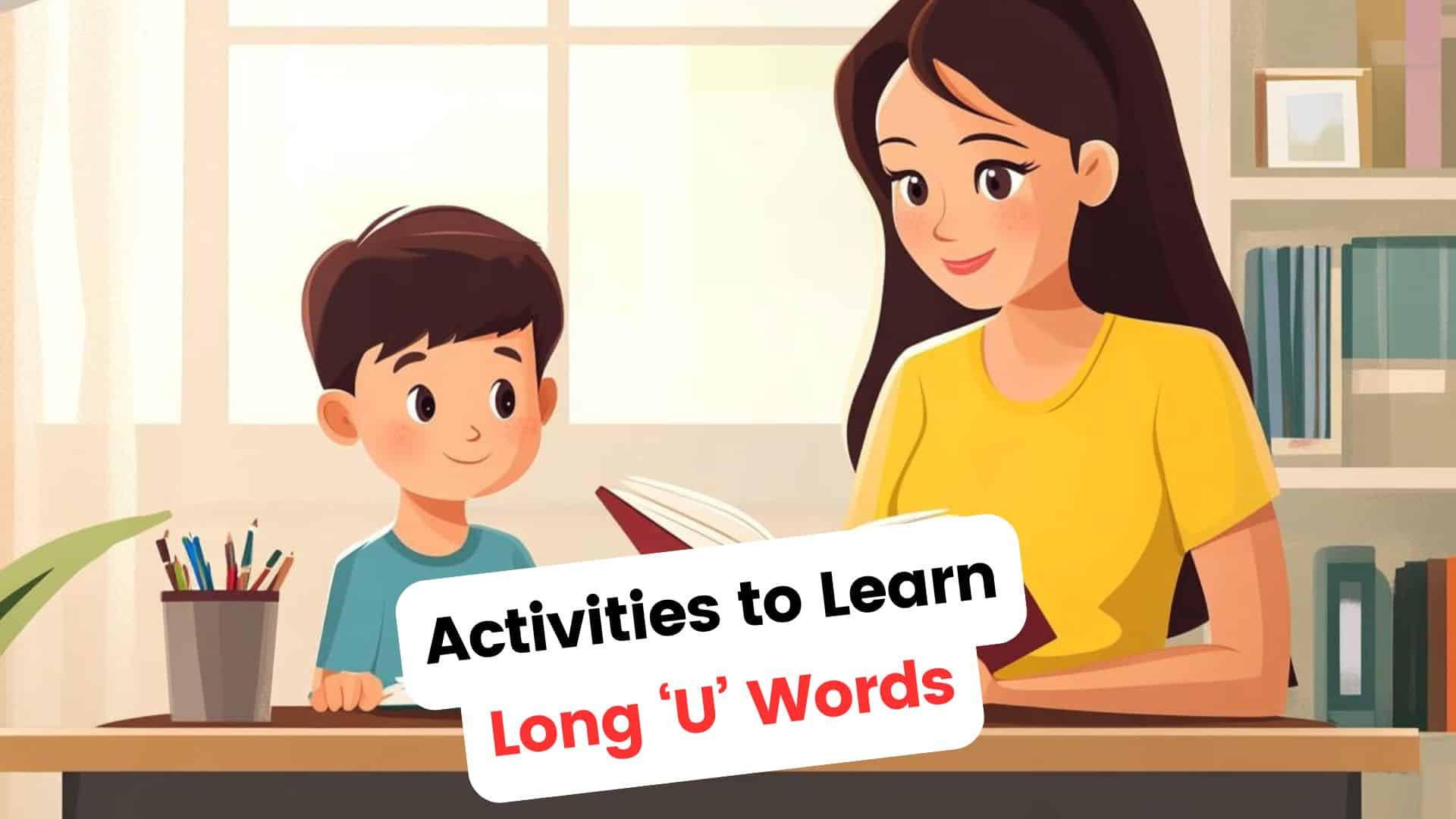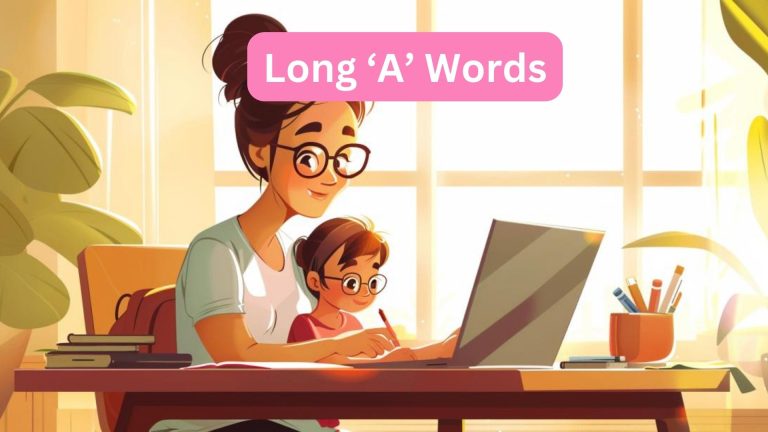Long U Words: Creative and Fun Activities for Kids
Learning to read and write is an exciting adventure for children, and mastering the intricacies of vowel sounds is a crucial part of this journey.
Among the five vowels, the letter U stands out as a unique challenge, with its ability to make two distinct long sounds.
In this comprehensive guide, we’ll explore the fascinating world of long U words and provide parents and educators with a wealth of fun and educational activities to help children master this tricky vowel sound.
From interactive phonics games to creative storytelling exercises, we’ll cover a range of engaging strategies that will make learning long U words a breeze.
So, whether your child is just starting to learn about vowel sounds or needs some extra practice with long U, get ready to dive into a world of educational fun!
List of Long U Words

1. Tube
- Meaning: A hollow cylinder used for transport or containment.
- Pronunciation: /tuːb/
- How to Teach: Use real-life examples and illustrations.
2. Flute
- Meaning: A woodwind musical instrument.
- Pronunciation: /fluːt/
- How to Teach: Listen to flute music and show pictures or videos.
3. Mule
- Meaning: A hybrid animal between a donkey and a horse.
- Pronunciation: /mjuːl/
- How to Teach: Discuss its role in agriculture with visuals.
4. Dune
- Meaning: A hill of sand formed by wind or water flow.
- Pronunciation: /djuːn/
- How to Teach: Show images of deserts and explain formation.
5. Cube
- Meaning: A solid object with six equal square sides.
Pronunciation: /kjuːb/
How to Teach: Use blocks to build cubes and discuss geometry.
6. Cute
- Meaning: Attractive in a charming way.
- Pronunciation: /kjuːt/
- How to Teach: Relate to cute animals or cartoon characters.
Vowel Team Words
7. Fruit
- Meaning: The sweet product of a tree or plant that contains seeds.
- Pronunciation: /fruːt/
- How to Teach: Discuss various fruits and have a tasting session.
8. Juice
- Meaning: A liquid extracted from fruits and vegetables.
- Pronunciation: /dʒuːs/
- How to Teach: Make juice in class and discuss health benefits.
9. Cruise
- Meaning: A voyage on a large ship for pleasure.
- Pronunciation: /kruːz/
- How to Teach: Show videos or brochures of cruise ships.
10. Bruise
- Meaning: A mark on the skin caused by bleeding under the surface after an impact.
- Pronunciation: /bruːz/
- How to Teach: Explain with health and safety lessons.
Unique Spellings
11. Blue
- Meaning: A color often associated with the sky or sea.
- Pronunciation: /bluː/
- How to Teach: Identify blue things in the classroom or outdoors.
12. Clue
- Meaning: Evidence or information that helps solve a mystery.
- Pronunciation: /kluː/
- How to Teach: Create a simple classroom detective game.
13. Through
- Meaning: From one end or side of something to the other.
- Pronunciation: /θruː/
- How to Teach: Demonstrate using objects and movement through spaces.
14. True
- Meaning: By fact or reality.
- Pronunciation: /truː/
- How to Teach: Play truth or false games with facts about nature or science.
UI and UE Combinations
15. Suit
- Meaning: A set of outer garments, typically trousers and a jacket.
- Pronunciation: /suːt/
- How to Teach: Discuss occasions where suits are worn and show pictures.
16. Glue
- Meaning: An adhesive substance used for sticking objects together.
- Pronunciation: /gluː/
- How to Teach: Arts and crafts session using glue.
17. Due
- Meaning: Expected or planned at a certain time.
- Pronunciation: /duː/
- How to Teach: Discuss the concept of deadlines and timing in projects.
18. Pursue
- Meaning: Follow or chase to catch or achieve something.
- Pronunciation: /pərˈsuː/
- How to Teach: Role-play or scenarios where goals are set and pursued.
Fun and Educational Activities to Teach the Long U Sound
1. Interactive Phonics Games
- Play “Long U Bingo,” where students match words to their corresponding long U sounds.
- Create a “Long U Word Hunt” where students search for words in texts or around the classroom.
- Develop a “Long U Memory Game” where students match word cards with their paired images.
- Use online phonics games focusing on long U sounds, such as “Long U Sorting” or “Long U Fill-in-the-Blank.”
Interactive phonics games are a fun and engaging way to reinforce long U spelling and pronunciation.
By participating in activities like “Long U Bingo,” “Long U Word Hunt,” or “Long U Memory Game,” students can practice identifying and using long U words in a playful context.
Online phonics games also provide an interactive platform for students to hone their skills independently or in small groups.
2. Crafting Stories
- Provide story starters with long U words, such as “The curious unicorn” or “A tune on the flute.”
- Encourage students to write acrostic poems using long U words, such as “B-L-U-E” or “F-R-U-I-T.”
- Have students create comic strips or picture books featuring characters or settings with long U names.
- Challenge students to write a collaborative story, taking turns to add sentences containing long U words.
Crafting stories is an excellent way to promote creative writing while reinforcing long U words.
Students can apply their knowledge of long U sounds in a meaningful and imaginative context by using story starters, writing acrostic poems, creating comic strips, or collaborating on a story.
This activity strengthens their understanding of long U words and enhances their writing skills and creativity.
3. Word Sorting Challenges
- Provide students with a list of long U words and have them sort the words by their spelling patterns (e.g., “u_e,” “ue,” “ui”).
- Create a “Long U Word Wall” where students can categorize words based on their spellings.
- Use manipulatives, such as letter tiles or word cards, for students to physically sort long U words.
- Encourage students to create sorting categories, such as “words with one syllable” or “words related to nature.”
Word sorting challenges help students recognize and categorize the various spelling patterns associated with long U sounds.
Students can deepen their understanding of how long U sounds are represented in written language by sorting words based on their spellings, creating a “Long U Word Wall,” using manipulatives, or devising their sorting categories.
This hands-on activity promotes critical thinking and reinforces long U-word recognition.
4. Magic E Explorations
- Create a “Magic E Wand” activity where students add a silent ‘e’ to short U words to transform them into long U words.
- Use picture cards to illustrate the difference between short U and long U words (e.g., “cub” vs. “cube”).
- Have students play “Magic E Go Fish,” where they match short U words with their long U counterparts.
- Encourage students to create “Magic E Posters” that showcase the transformative power of the silent ‘e’ in long U words.
Magic E explorations demonstrate how the silent ‘e’ changes the pronunciation of short U words to long U words.
By participating in activities like “Magic E Wand,” using picture cards, playing “Magic E Go Fish,” or creating “Magic E Posters,” students can visualize and internalize the role of the silent ‘e’ in altering vowel sounds.
These engaging activities make the concept more tangible and memorable for young learners.
5. Rhyming Word Competitions
- Host a “Long U Rhyme Time” contest where students compete to generate the most rhyming words for a given long U word.
- Create a “Long U Rhyme Relay” where teams take turns adding rhyming words to a chain.
- Encourage students to write “Long U Rhyming Poems” that showcase their understanding of long U sounds and rhyme schemes.
- Play “Long U Rhyme Bingo,” where students match long U words with their rhyming counterparts.
Rhyming word competitions provide an engaging and interactive way to reinforce long U pronunciation and develop phonemic awareness.
By participating in contests like “Long U Rhyme Time,” “Long U Rhyme Relay,” writing “Long U Rhyming Poems,” or playing “Long U Rhyme Bingo,” students can practice identifying and generating words that rhyme with long U words.
These activities foster a sense of camaraderie and friendly competition while strengthening long U-word mastery.
6. Multimedia Learning Tools
- Use educational apps focusing on long U sounds like “Starfall” or “ABC Mouse.”
- Show videos that teach long U words through songs, animations, or storytelling.
- Create interactive smartboard activities that allow students to manipulate long U words and sounds.
- Incorporate podcasts or audiobooks that feature stories with long U words to reinforce auditory recognition.
Multimedia learning tools offer a dynamic and multisensory approach to teaching long U sounds.
Students can engage with long U words through various modalities, such as educational apps, videos, interactive smartboard activities, podcasts, or audiobooks.
These tools often include colorful visuals, catchy tunes, and interactive elements that capture students’ attention and make learning more enjoyable.
Wrapping Up
In conclusion, mastering long U words is a crucial milestone in every child’s literacy journey.
Understanding this unique vowel sound’s various spell sounds and pronunciations can help children become more confident readers and writers.
Through engaging activities like interactive phonics games, crafting stories, and magic E explorations, kids can practice long U words in a fun and meaningful way.
Parents and educators play a vital role in supporting this learning process by providing ample opportunities for practice, celebrating progress, and fostering a love for language.
As children develop a strong foundation in long U sounds, they unlock endless possibilities in their academic and personal lives.
So, let’s encourage our young learners to embrace the power of Long U and watch them soar to new heights!








